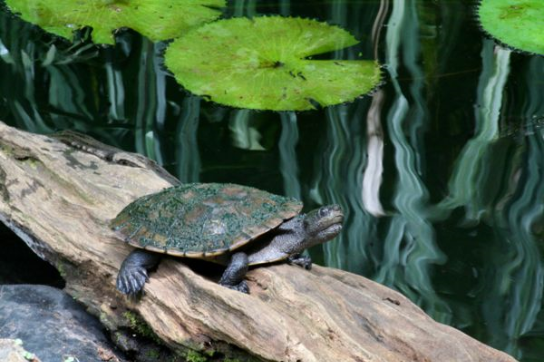


Australian turtles are either freshwater or saltwater species. Freshwater turtles are smaller than saltwater turtles, and have clawed feet with strong webbing as opposed to the saltwater species whose legs have been modified to paddle-like flippers. There are not many species of turtles in Australia - only 16 freshwater species and six species of sea turtle. Australia has no land tortoises.
 Freshwater turtles
Freshwater turtles
There are four species of freshwater turtle in the Wet Tropics area. A commonly seen turtle is the saw-shelled turtle (Wollumbinia latisternum). The female is considerably larger than the male with a shell length (carapace) up to 28cm long compared to the males which rarely get bigger than about 18cm. The shell has marginal serrations which are the reason for its common name, the saw-shelled turtle. It has a large head with a projecting snout and a horny plate on the top. The neck is of a medium length as opposed to a few other Australian species which are known for their very long necks. The neck can fold sideways. The feet are webbed and also clawed.
The saw-shelled turtle feeds on a variety of material including pandanus fruits, molluscs, crustaceans, fish, tadpoles, frogs, aquatic insects and is one of the few native Australian animals successful in preying on the introduced and very poisonous cane toad (Rhinella marina). Toads too large to swallow whole are first shredded with their front claws.
The best time to see the freshwater turtles is in the middle of the day when they bask near water surface or climb onto rocks and logs.
 Marine turtles
Marine turtlesSix species of marine turtles live in Australian waters. They are all protected under the Australian Government's Environment Protection and Biodiversity Conservation Act 1999. The leatherback, loggerhead and olive ridley turtles are all listed as endangered. The green, hawksbill and flatback turtles are each listed as vulnerable. A recovery plan has been developed to help prevent their decline.
While these beautiful animals are mainly a feature of the neighbouring Great Barrier Reef World Heritage Area, some of the six turtle species have been found nesting on beaches within the Wet Tropics. Feral animals such as pigs can devour turtle eggs and weeds such as Singapore daisy taking over coastal dunes can affect their ability to nest.